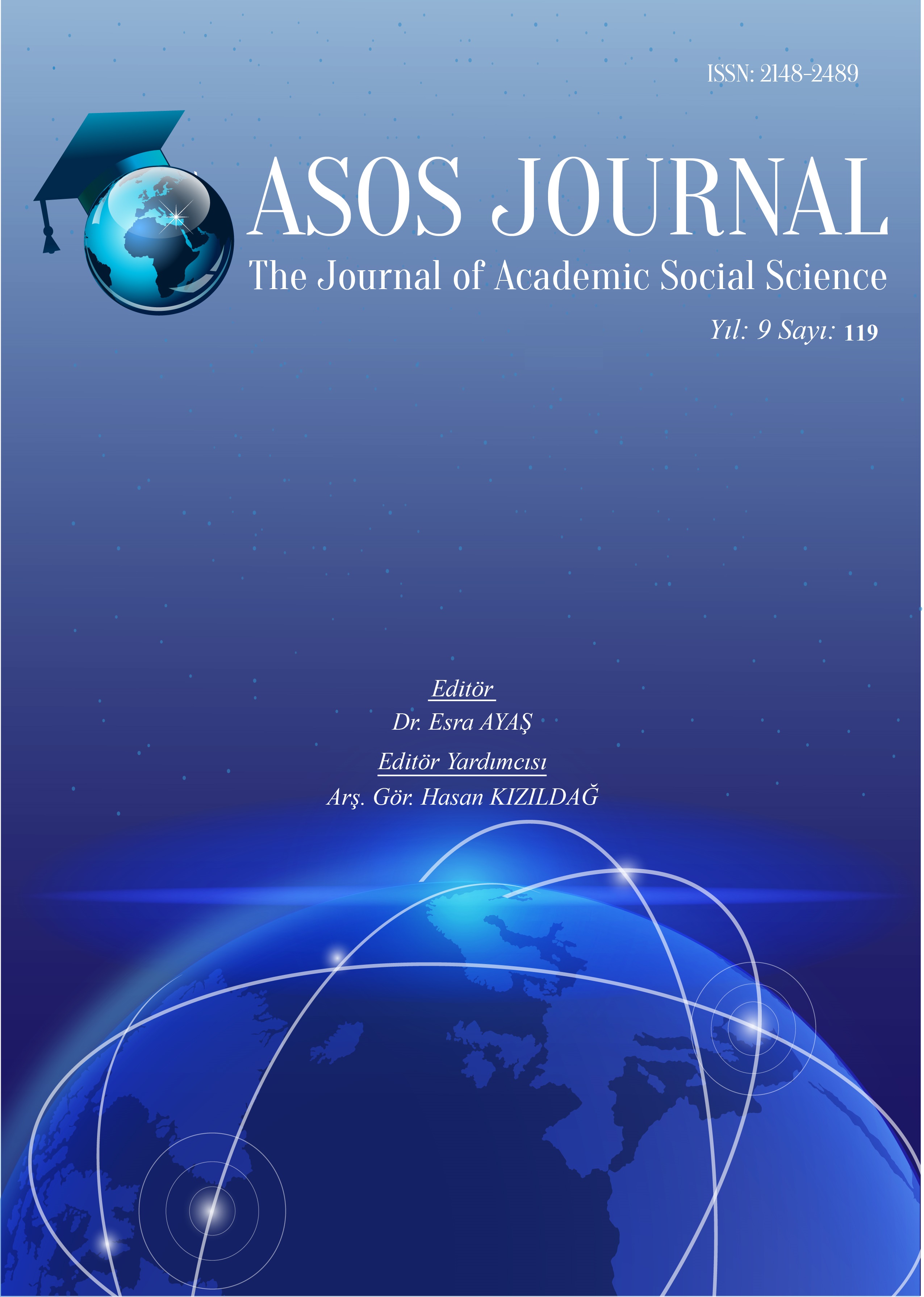Author :
Abstract
Yabancı dil olarak Türkçe öğretimi alanı, uluslararası standartları yakalama anlamında son yıllarda önemli dönüşümler geçirmektedir. Materyal tasarımı, nitelikli içerikler ve etkinlikler, öğretim programı, görsel tercihi de bu dönüşümün alt başlıklarından biridir. Görseller bilişsel açıdan da fiziksel açıdan da öğretim sürecinin önemli aktörlerinden biridir. Görseller aracılığı ile öğrenilen bilgilerin kalıcılığı, kullanımı, verimi artmaktadır. Materyallerde kullanılan görsellrin nitelikleri sürecin tüm etmenlerini etkilemektedir. Doğal olarak materyallerde kullanılan görsellerin mahiyetleri, kullanışlılığı önemli bir araştırma konusudur. Nitel araştırma yönteminin benimsendiği bu çalışmada yabancı dil olarak Türkçe öğretimi sürecinde yurt içinde TÖMER kurumlarınca; yurtdışında ise Maarif Vakfı tarafından kullanılan Türkçeye Yolculuk yabancı dil olarak Türkçe öğretimi setinde yer alan görsellerin sıklıkları ve işlevleri incelenmiştir. Araş-tırmanın verilerini oluşturan görseller, doküman incelemesi ile toplanmış; görsellerin işlevleri içerik analiziyle tespit edilmiştir. Görseller işlevleri bakımından temsilî, dekoratif, açıklayıcı/yorumlayıcı, dönüşümsel, organizasyonel olmak üzere 5 başlığa kategorize edilmiştir. Elde edilen verilerden hareketle materyaller bünyesinde temsilî işleve sahip görseller baskın şekilde öne çıkarken ardından dekoratif işleve sahip görsellerin geldiği saptanmıştır. Açıklayıcı/yorumlayıcı, dönüşümsel ve organizasyonel işleve sahip görsellerin materyallerde neredeyse hiç kullanılmadığı saptanmıştır. Bilişsel süreçler açısından hedef kitlenin öğrenme sürecini olumlu etkileyen, hatırlama sürecini kısaltan, bilginin kalıcılığını artıran dönüşümsel ve organizasyonel işleve sahip görsellerin kullanılmaması ya da çok az kullanılması materyal verimliliği açısından olumsuz bir durum olarak değerlendirilmiştir.
Keywords
Abstract
The field of teaching Turkish as a foreign language has undergone significant transformations in recent years in terms of catching up with international standards. Material design, qualified content and activities, curriculum, and visual preference are also subtitles of this transformation. Visuals are one of the important actors of the teaching process both in terms of cognitive and physical aspects. The permanence, use and efficiency of the information learned through visuals increase. In the visuals used in the materials, these qualities affect all the factors of the process. Naturally, the nature and usefulness of the images used in the materials is an important research topic. In this study, in which the qualitative research method was adopted, in the process of teaching Turkish as a foreign language, by TÖMER institutions in Turkey; The frequencies and functions of the visuals included in the set of Journey to Turkish, which is used by the Maarif Foundation abroad, for teaching Turkish as a foreign language were examined. The visuals constituting the data of the research were collected by document analysis; analyzed by content analysis in terms of functions. Images are categorized in terms of their functions under 5 titles as decorational, representational, organizational, interpretational, and transformational. Based on the data obtained, it was determined that while the visuals with a representational, function in the materials were dominant, visuals with a decorative function followed. It has been de-termined that visuals with interpretational, transformative and organizational functions are almost never used in the materials. In terms of cognitive processes, not using or using very little visuals with transformative and organizational functions that positively affect the learning process of the target audience, shorten the recall process, and increase the permanence of information is considered as a negative situation in terms of material efficiency.
Keywords
- Basal, A., Celen, K. M., Kaya, H., & Bogaz, S. N. (2016). An Investigation into Illustrations in English Course Books in a Turkish Context. International Electronic Journal of Elementary Education, 8(3), 525-536.
- Carney, R. N., & Levin, J. R. (2002). Pictorial illustrations still improve students’ learning from text. Educationalm Psychology Review, 14(1), 5-26. http://dx.doi.org/10.1023/A:1013176309260
- Evans, M. A., Watson, C., & Willows, D. M. (1987). A naturalistic inquiry into illustrations in instructional textbooks. In H. A. Houghton & D. M. Willows (Eds.). The psychology of illustration. Vol.2: Instructional issues (pp. 86−115). New York: Springer. http://dx.doi.org/10.1007/978-1- 4612-4706-7_3
- Hsieh, H. F., & Shannon, S. E. (2005). Three approaches to qualitative content analysis. Qualitative Health Research, 15(9), 1277-1288.
- Krippendorff, K. (2004). Reliability in content analysis. Human Communication Research, 30(3), 411-433.
- Laitinen, M. (2014). Thousands of words. A comparative study on the functions of pictorial illustrations in English language textbooks. (Unpublished master's thesis). Retrieved from https://jyx.jyu.fi/dspace/handle/123456789/43121
- Levin, J. R., & Mayer, R. E. (1993). Understanding illustrations in text. In B. K. Britton, A. Woodward, & M. Binkley (Eds.). Learning from Textbooks: Theory and Practice (pp. 95−113). New Jersey: Lawrence Erlbaum Associates
- Levin, J. R., Anglin, G. J., & Carney R. N. (1987). On empirically validating functions of pictures in prose. In D. M. Willows & H. A. Houghton (Eds.) The psychology of illustration, volume 1: Basic research (pp. 51−85). New York: Springer-Verlag. http://dx.doi.org/10.1007/978-1-4612-4674- 9_2
- Mayer, R. E. (1993). Illustrations that instruct. In R. Glaser (Ed.), Advances in instructional psychology, Volume 5 (pp. 253-284). Hillsdale, JH: Erlbaum.
- Molitor, S., Ballstaedt, S. P., & Mandl, H. (1989). Problems in Knowledge Acquisition from text and Pictures. In Mandl, H. & Levin, J. R. (eds). Knowledge Acquisition from text and Pictures, 3-35. North Holland: Amsterdam, New York, Tokyo. http://dx.doi.org/10.1016/S0166-4115(08)62145-7
- Olshansky, B. (2008). The Power of Pictures: Creating Pathways to Literacy through Art. grades K–6. San Francisco: Jossey-Bass.
- Romney, C. (2012). Images in ELT textbooks: Are they just decoration? In A. Stewart & N. Sonda (Eds.), JALT2011 Conference Proceedings. Tokyo: JALT.
- Stemler, S. (2001). An overview of content analysis. Practical Assessment, Research & Evaluation, 7(17), 137-146.
- Tavşancıl, E., & Aslan, A. E. (2001). Sözel, yazılı ve diğer materyaller için içerik analizi ve uygulama örnekleri. Epsilon.
- Toprak, F. (2011). Yabancılara Türkçe öğretimi kitaplarındaki okuma parçaları ve diyaloglar üzerine bir değerlendirme. Selçuk Üniversitesi Türkiyat Araştırmaları Dergisi, 29, 11
- Woodward, A. (1993). Do illustrations serve an instructional purpose in U.S. textbooks?. In B. K. Britton, A. Woodward, & M. Binkley (Eds.). Learning from textbooks: Theory and practice (pp. 115−134). New Jersey: Lawrence Erlbaum Associates.
